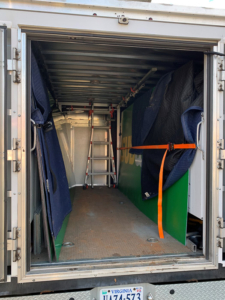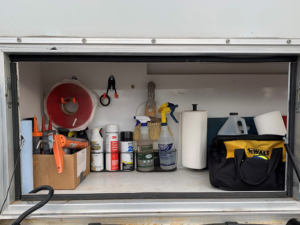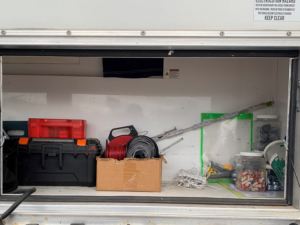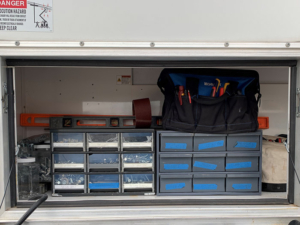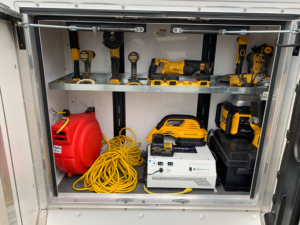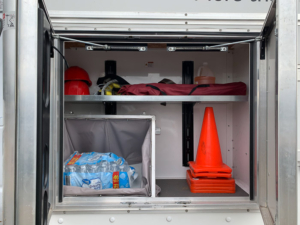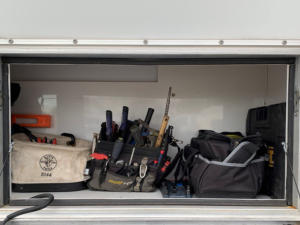An Installation Center with a Lift on Top
At a recent sign convention, a customer told me that we are not marketing our truck properly. Ordinarily, I’d take offense—being the marketing guy, and all—but Steve Adrian at FASTSIGNS in Forest, VA, has earned my ear. He’s one of those guys who is as entertaining in how he says something as he is informative in what he says.
“What are you talkin’ about?” I asked, acting surprised (I was trying to keep the illusion of marketing prowess).
“Think of it like this:” he replied. “When I bought my Van Ladder, I bought an installation center that happens to have a lift on top.”
“Yeah?” I mumbled, waiting for more.
Steve could see I wasn’t really getting it, so he showed me one of the other trucks at the show. It was an aerial lift mounted on a flatbed with a two-person basket. “Okay,” he said, “Let’s assume whoever owns that truck needs to install a 5’ x 10’ panel behind the receptionist’s desk at a dental office. Will he drive that truck to an indoor install like that?”
Staring at the huge vehicle, I shook my head.
“Of course not,” Steve agreed. They only use that truck to hang their outdoor signs. It’s a uni-tasker. He probably has a Ford Transit van at his shop for the indoor stuff. Do you know how much a new Ford Transit costs?
Again, I shook my head.
“Between fifty and sixty grand! But that only gives you the shell. Now you need to build the inside with shelves and compartments for all your installation stuff. That isn’t cheap! By the time you’re done, you’ve paid for over half a new Van Ladder.”
Steve was beginning to make sense. I said, “So, you’re telling me that you do all of your indoor installs from the Workport box?”
“Of course,” he said, pointing at our truck. “With all that room, and all those compartments, it’s set up better than a Transit van could ever be. Maybe it doesn’t get quite the mileage, but the difference in gas cost doesn’t begin to offset with the efficiency of having a single mobile center to handle all of my installs. The Van Ladder is our primary install vehicle, whether the boom is used or not. The boom is just ONE of the features that makes it an ideal install vehicle. The inverter, the compartments, the ability to transport large substrates safely. EVERYTHING we need to do ANY job is a permanent and re-filled item on that truck – fasteners, tools, (battery and corded), paint, adhesives, electrical parts.”
Then he looked me in the eye, and said, “Do you hear what I’m telling you? . . . You guys are marketing the Van Ladder as a bucket truck with wonderful storage, but you should be marketing it as an installation center with an aerial lift on top. That’s all I’m trying to say.”
At the hotel that night, during a mesothelioma ad on the Grit channel, I replayed the conversation in my head and concluded that Steve was right: We haven’t been marketing the back end of our truck properly.
Back at my office, I called Steve and asked him to send photos of the open compartments to his Workport box. When I had all the photos in front of me, I called him, and he walked me through each one.
I’ll do the same with you right now, if you have a little time.
Project Area:
Finished panels go from the shop to the back of the truck, and stay there, safe and sound. When we finish a piece, we want it out of the shop—out of harm’s way. But we want to handle it as few times as possible. The panels are set against the wall with a rachet strap and that’s it until they’re installed.
The 24’ ladder fits perfectly upright in the front of the box. On the shelves (behind the panels) are folded moving blankets to cover the signs. There are also large coils of electrical conduit up there. When we remove lamps from existing cabinets, the fluorescent tubes go up on the shelves, too. On the floor behind the panels are the 4’ clamps. If he’s going to dig a hole, he’ll have the auger in there. The slider door opens to allow a 14’ post. A 12’ post fits without using the slider door. Rolled vinyl for upcoming jobs sits on those shelves, too, along with my longer levels.
Of course, the larger accessories for the Chariot Bucket have their own special out-of-the-way place back there.
Box #1: Cleaning supplies and vinyl tools
We have certain hit-and-run projects that take as little as 10 or 15 minutes (For example, installing a logo on a glass door). So this is the 10-minute box. If my installer has a few minutes before lunch, or at the end of the day, this is his go-to box. All the holders and brackets are permanently installed to keep things from moving around.
- Black and white spray paint
- Adhesive remover
- Wet application fluid
- Alcohol and paper towels.
- Clear double-sided VHB (very high bond) tape
- Adhesives
- Bag with vinyl tools (squeegees, knives)
This compartment is also used when cleaning up at the end of a job. It’s on the driver’s side because it’s the most frequently opened compartment. Because vinyl is extremely fragile, it is stored inside on the top shelves. If the vinyl gets wrinkled or folded, the whole job is screwed up. We can do three or four jobs in a day if they’re medium to small—because we have everything on the truck, everything is in its place, and things aren’t getting damaged.
Box #2: Electrical
- First aid kits.
- Electrical hookups:
- Different types of wire
- Fish tape
- Wire nuts
- Liquid-tight connectors
Box #3: Fasteners
- The organizers are screwed into the metal.
- The non-transparent organizer contains the heavier hardware. I’ll replace it with a transparent organizer if I find one strong enough.
- Inside the drawers are fasteners (for drywall, masonry, wood, steel) because you don’t want the truck running to Lowes to buy hardware. It kills your profits.
- We buy boxes of fasteners at quantities of 1,000 or 1200 and store them at the shop. My installer routinely stocks these organizers from the larger boxes.
- Black bag (Adam’s electrical bag—wire strippers, meter, etc.)
- Drill bits and driver cases
Box #4 Power tools
- DeWalt battery charger on top of inverter.
- Vacuum cleaner
- Light for attic crawl spaces for fishing wire
- Pigtail for sign testing
- Tools are held in place with DeWalt’s mount adapters (found on Amazon). An empty adapter signals a lost or forgotten tool. Again, everything is in its place.
Box #5: Safety items
- Project bag (It just fits nice in there).
- Water
- Cones
- Hard hats
- Chair
- Fall arrest equipment.
Box #6: Miscellaneous
- Pattern arm clamps
- Face bar clamps
- Shackles
- Straps
- Hand tools
- Pass through rachet set.
- DeWalt toolbox (our back up kit) and Unicorn tools (hardly ever tools—until you need it).
- I love that the doors are worktables.

